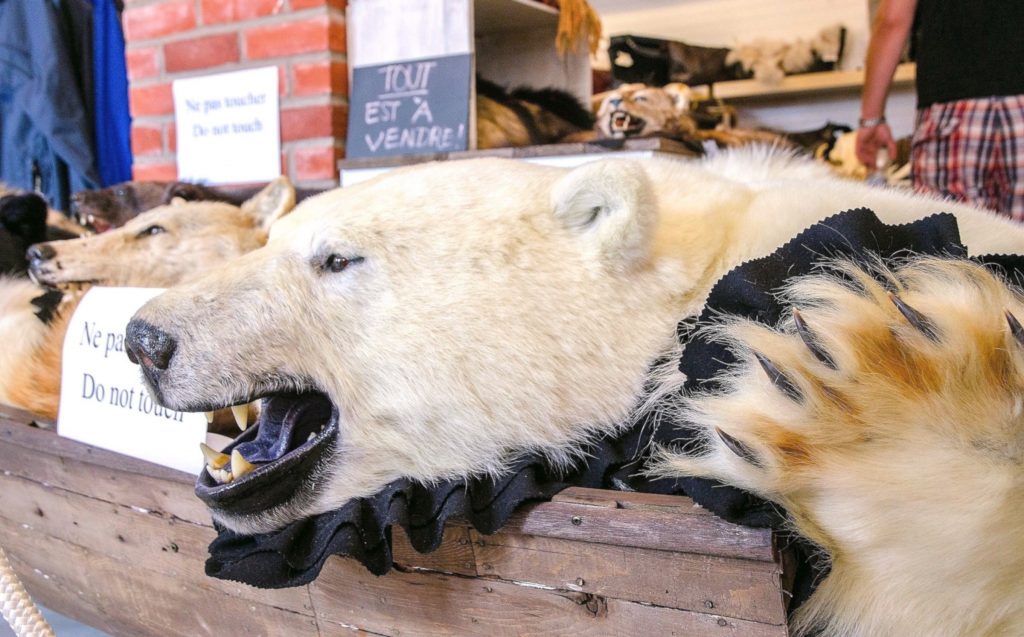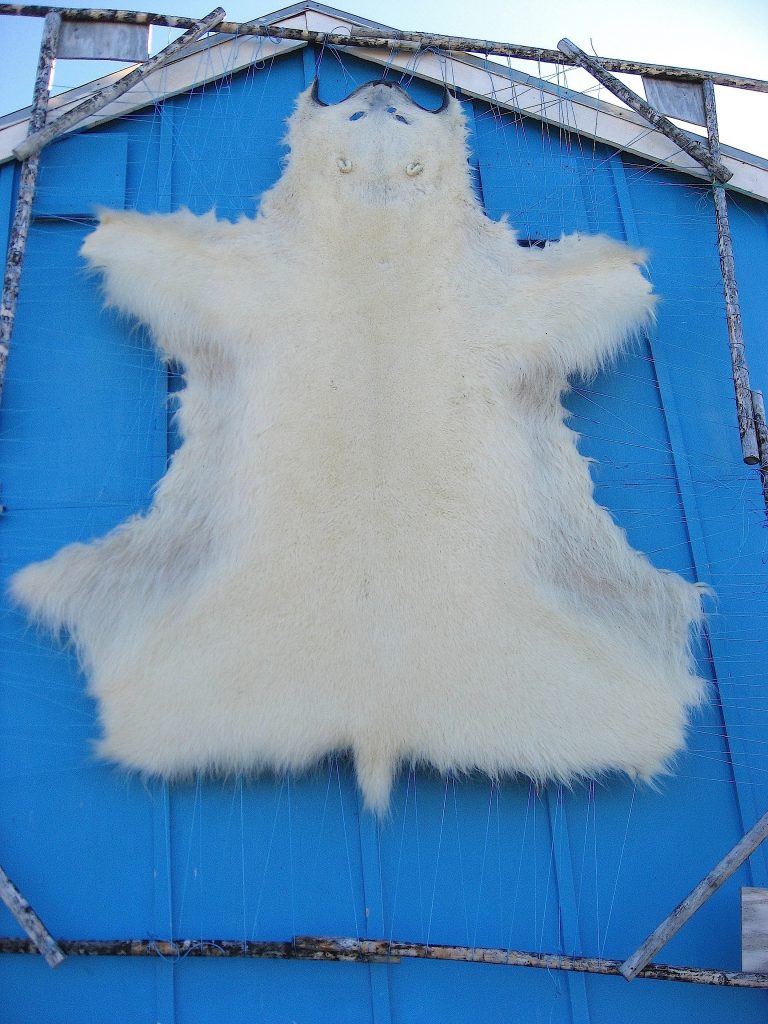By Michael Engelhard*

In the new millennium’s politics, polar bears play the part whales played in the 1980s. From a theatrics-as-protest perspective, their shape lends itself better to impersonation than that of a rainforest or whale. Activists take advantage of this. Dressed as polar bears, they show up in the most unlikely places—the Kremlin, or Ottawa’s Parliament Hill—as nonhuman “climate refugees. In an act billed as “part protest, part performance,” Greenpeace paraded a mechanical polar bear the size of a double-decker bus through central London, as part of its Save the Arctic campaign. Fifteen puppeteers operated Aurora the bear, which had an articulated head and neck, a mouth like an ice cave, and the real bear’s “slightly lazy” ambling gait.

When climate change became a pressing political issue, zoos that had closed polar bear exhibits or were planning to do so because of their high costs reversed course, making sure polar bears were on hand. In part, this reflected zoo visitors’ growing interest. But zoos also stepped up their breeding programs when the species was listed as threatened—many of their bears were well past the reproductive age. They soon increased their holdings also with abandoned cubs and “problem” bears removed from the Arctic.
Like captive breeding programs and reintroduction efforts in general, science-assisted interventions in the field raise the question of what constitutes wildness, or the bearness of polar bears. One of several emergency actions proposed to relieve starving bears has helicopters airlift food to the “most accessible” ones—at a cost of thirty-two thousand dollars per day. (Similar programs already exist for intensely managed animal species and populations such as the California condor, black bears in Washington, and brown bears in Eastern Europe.) Other last-ditch efforts biologists suggest include relocating bears farther north, where sea ice will last longer; moving more bears to zoos; and even euthanizing those unlikely to survive on their own. Some Inuit who decry even the radio-collaring of polar bears as disrespectful to the animals and who are tired of “outsiders” meddling say to just let them be.
With the polar bear caught in the media’s limelight, some Canadians began to consider it a more fitting national emblem than the beaver. In an attempt to oust the official signature animal—“the dentally defective rat”—one senator reminded her fellow citizens that a country’s symbols are not constant and can change over time. The polar bear would be perfect for the part, with its “strength, courage, resourcefulness, and dignity.” An opponent countered that “you can’t beat a beaver for stoic hard work and industry,” a perfect metaphor for the pioneering Canadian spirit. Such resistance shows the difficulties of rebranding, with brand loyalty in this case entrenched for more than thirty-six years.
When the senator pitched it as a new national symbol, the polar bear had already reinvigorated Canada’s oldest trade, which the animal rights movement’s stance against wearing fur had previously damaged. Since the bear’s numbers were thought to have declined and restrictions on hunting it consequently increased, its value as status symbol rose, to a level comparable to its first appearance in Europe during the Middle Ages. Sports hunters now pay up to thirty thousand dollars to shoot a polar bear in Canada. In the last five years, the price of pelts alone doubled, with the best selling for twenty thousand dollars or more. Even in small amounts, legal polar bear hair, used in fly-fishing, is hard to obtain. Like real flies, lures made with the hollow hairs settle gently on water. There is no equivalent, and patches of pre-treaty skin with hair sell for six dollars per square inch in the United States.

All this encourages poaching, especially in Russia, where forty to two hundred bears are killed each year. Their skulls and skins enter the market with false Canadian documentation, the forging of which itself is a lucrative business. The resurgent demand for fur rugs, claws, carved masks with polar bear fur, and similar items comes largely from Russia and China, where a growing middle class spends money on status symbols that are passé in the West. South Koreans, on the other hand, buy dried polar bear gallbladders for “medicinal” uses, at three thousand dollars a piece.
Canadian politicians say that initiatives to outlaw such trade or hunting are based more on emotion than on science and that the hunting quotas are sustainable. (Inuit and trophy hunters kill about six hundred polar bears per year.) In the feelings it awakens, this controversy resembles the “seal wars” of the 1970s and 1980s, when big-eyed, white “baby” harp seals clubbed on sea ice caused furor and even French sex symbols became activists. Impassioned appeals, however disguised, come from both sides. “A ban would affect our ability to buy the necessities of life, to clothe our children,” an Inuit representative at the 2013 CITES conference said. “We have to protect our means of putting food on the table and selling polar bear hides enables us to support ourselves.” Perhaps by intention, this statement counts on our empathy, on our instinct to nurture and protect the human young and frail.

The same Native spokesman redirected the discussion toward the root cause of the polar bear’s plight. He accused the United States of compensating for its lack of action on climate change and pollution of the Arctic from drilling and mining, of using the polar bear as a blunt tool, because it is “the perfect poster child.”

Like the bear Viking merchants traded to Europe’s nobility, the emblem of nature conservation is precious as a commodity and as a pawn in political maneuvers. Even if we never reach the point where polar bears are fed bear kibble from helicopters, bears today, managed and marketed, no longer seem quite “pure” or genuinely wild. While the blending of consumer logos and wildlife might strike some people as odd, it is also no longer limited to the corporate sector. The previous president of Polar Bears International, a former marketing director, was dedicated to turning the bear into a recognizable environmental brand, promoting the bears’ situation through guided tours outside Churchill. Still, overexposure and a desensitized public could weaken the message and the “Lord of the Arctic” fade to a new cliché. Some critics think polar bears have already begun to disappear in the white noise of our culture. “The polar bear has lost a lot of its cachet,” the writer Jon Mooallem said in an interview. “It’s become too political. It doesn’t really resonate with environmentalists anymore and it ticks off everyone else.” Summing up the dilemma of image, Mooallem claimed that, “In the twenty-first century, how species survive, or go to die, may have to do more with Barnum than with Darwin.”
It may have to do even more with Konrad Lorenz, Marshall McLuhan, and Jean Piaget. It has to do more with Lorenz, because he ferreted out the dynamics between market forces and ecological catastrophes (outlined in his 1973 book Civilized Man’s Eight Deadly Sins); with McLuhan, because he realized how the medium shapes the message; and with Piaget, because he stressed learning from the past and teaching our children well. These three figures supersede Barnum, as better promotion of the polar bear will only get us so far. What really is needed is a drastic restructuring of our society, or at least, our economic system.
With our tendency to mess things up and then try to fix them—culminating at present in desperate schemes of geo-engineering—we find it hard to accept that perhaps the polar bear’s time is running out. And that ours could be too.
*Michael Engelhard is the author of a new essay collection, American Wild, and of Ice Bear: The Cultural History of an Arctic Icon, from which this essay has been excerpted. He lives in Fairbanks, Alaska and works as a wilderness guide in the Arctic.